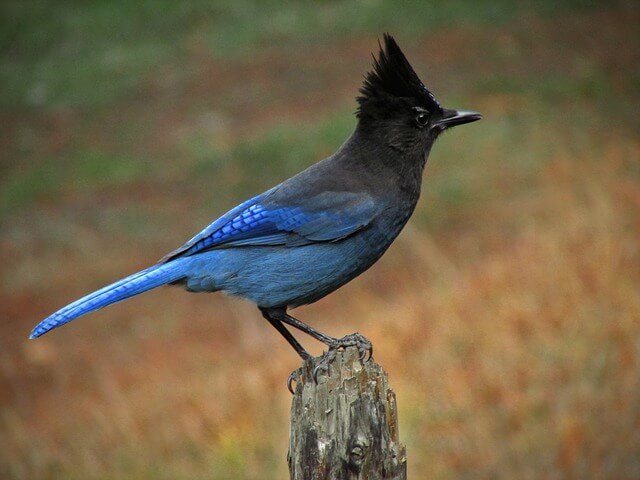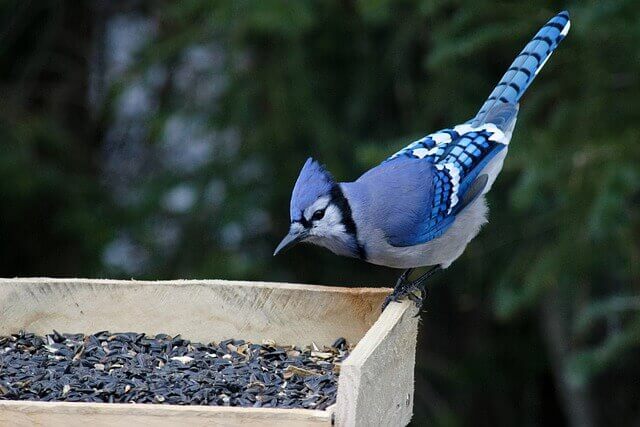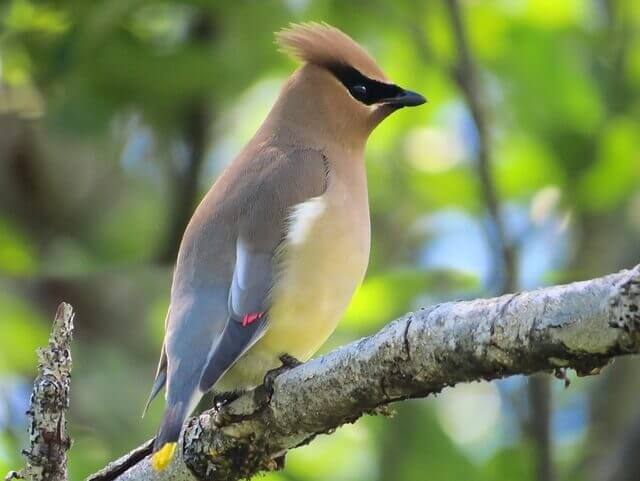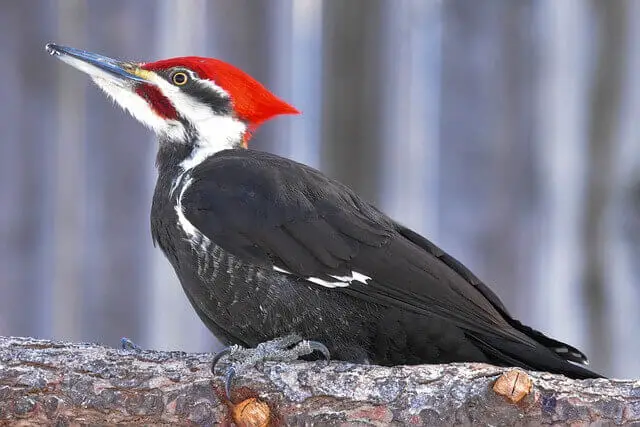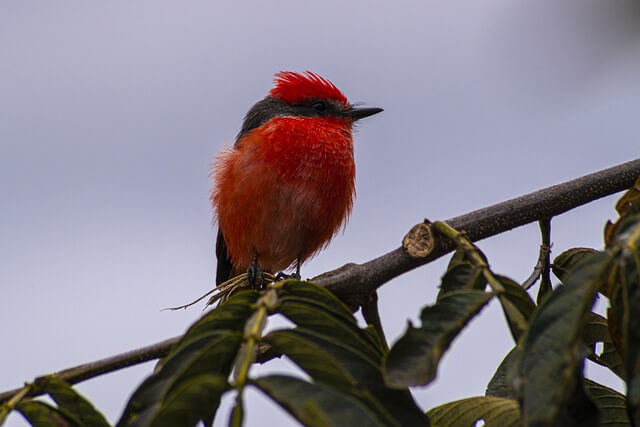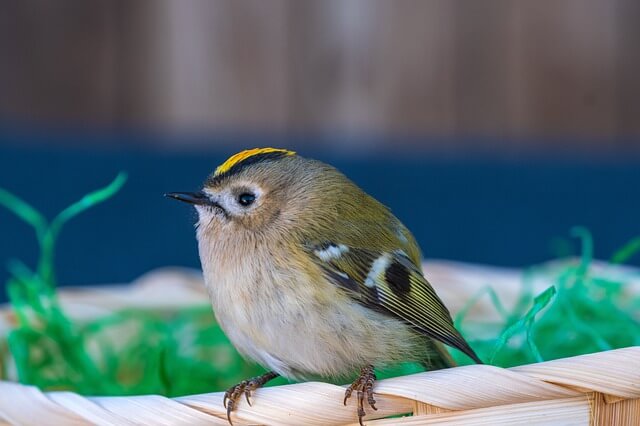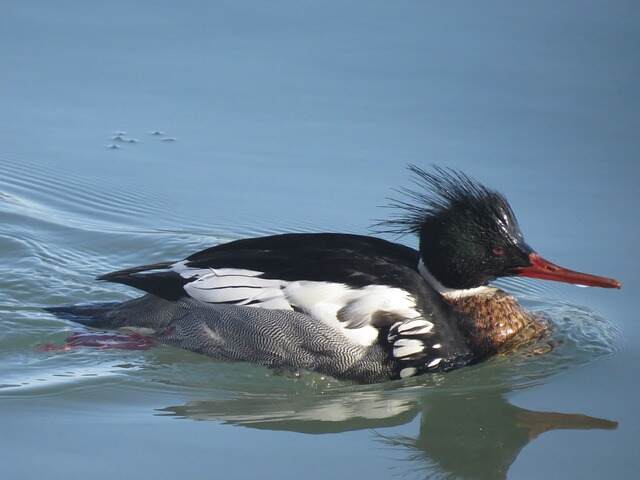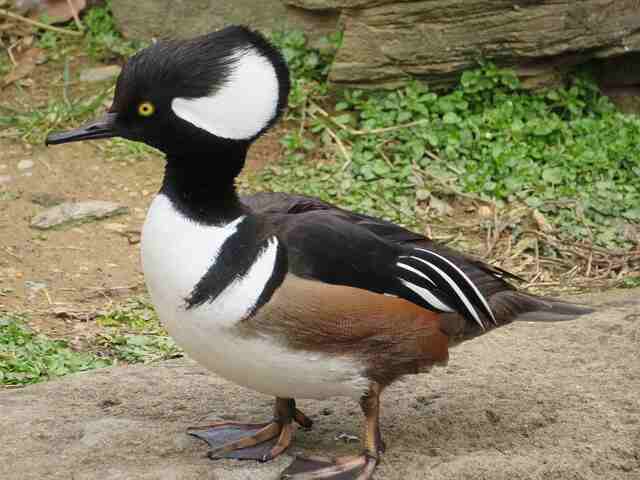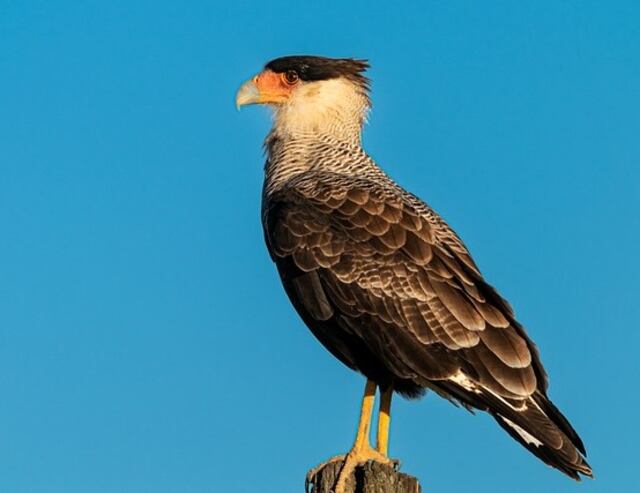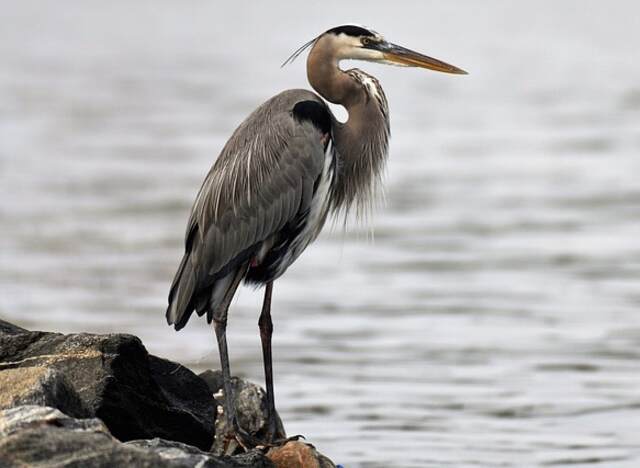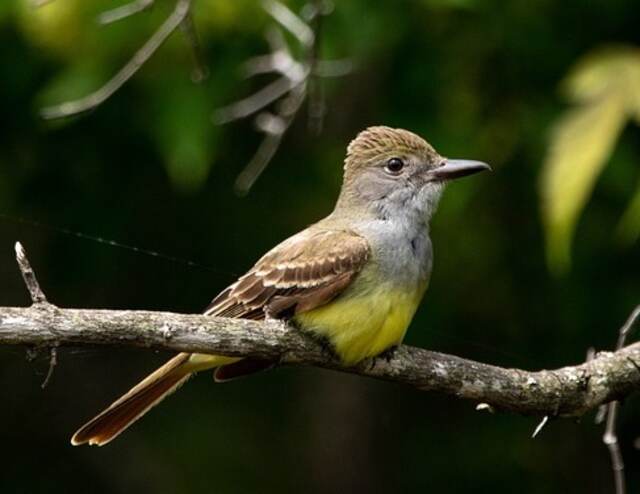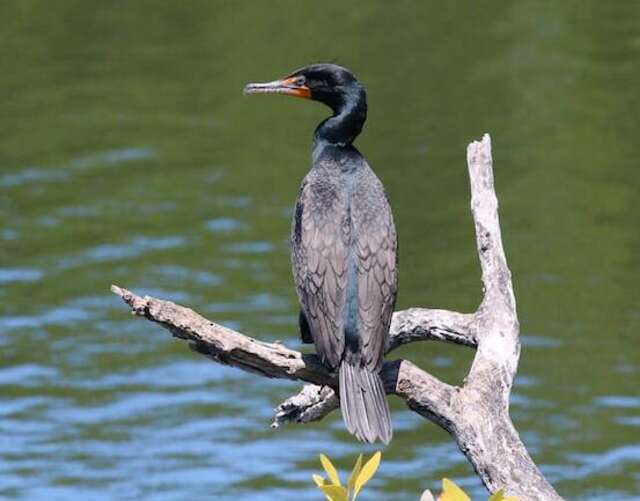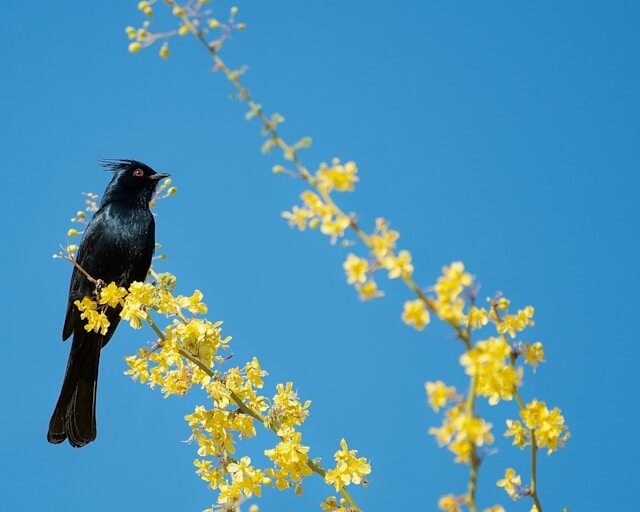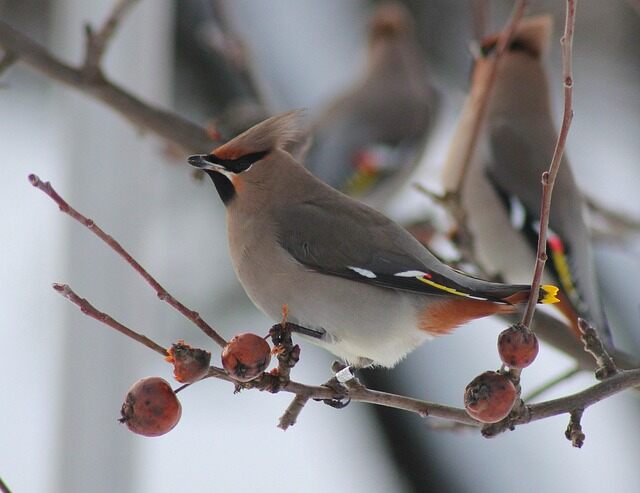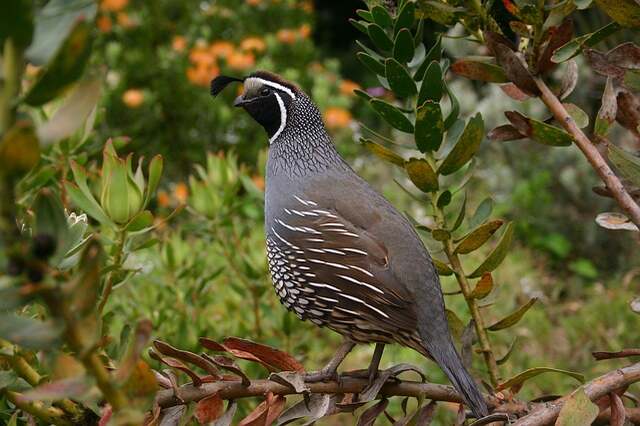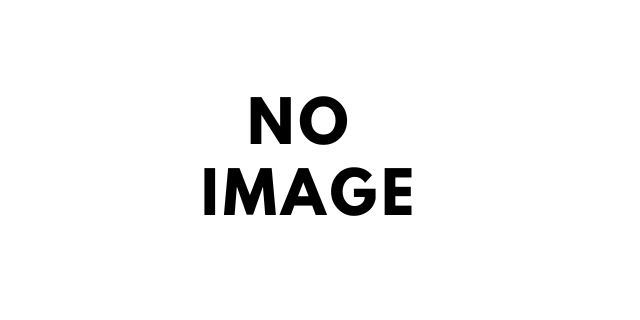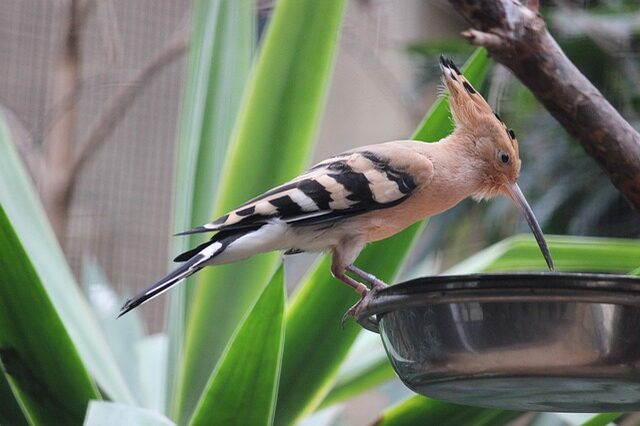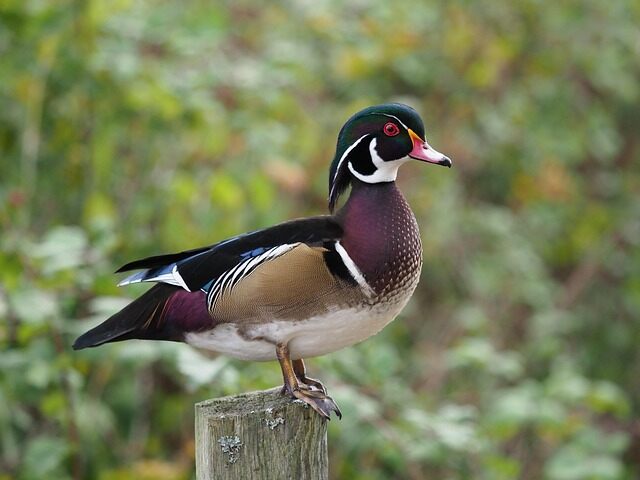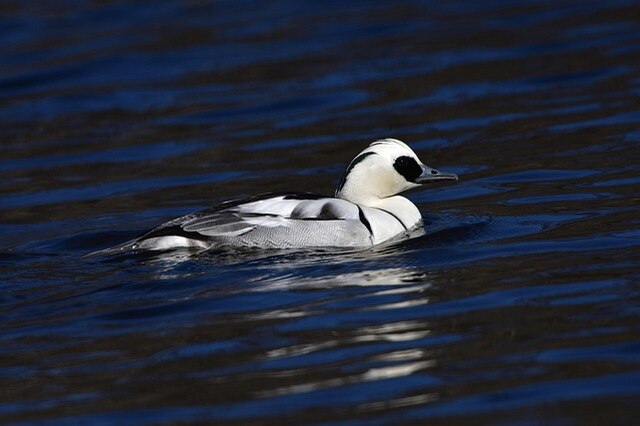Some of the most eye-catching birds in North America have crests. These feathered headpieces give species like the Northern Cardinal and Cedar Waxwing a bold and unique look. Crests are more than just decoration. They help birds communicate, attract mates, and even warn off threats. Whether you’re an avid birdwatcher or just curious, this guide will introduce you to 24 fascinating birds with crests of North America.
Table of Contents
- 1 Types of Crests and Their Functions in Birds
- 2 Different Functions of Crests in Birds
- 3 Birds With Crests Of North America
- 3.1 Steller’s Jay
- 3.2 Blue Jay
- 3.3 Northern Cardinal
- 3.4 Tufted Titmouse
- 3.5 Oak Titmouse
- 3.6 Cedar Waxwing
- 3.7 Pileated Woodpecker
- 3.8 Vermilion Flycatcher
- 3.9 Ruby Crowned Kinglet
- 3.10 Golden-crowned Kinglet
- 3.11 Red-breasted Merganser
- 3.12 Hooded Merganser
- 3.13 Crested Caracara
- 3.14 Great Blue Heron
- 3.15 Great Crested Flycatcher
- 3.16 Double Crested Cormorant
- 3.17 Phainopepla
- 3.18 Bohemian Waxwing
- 3.19 California Quail
- 3.20 Scaled Quail
- 3.21 Eurasian Hoopoe (Rare vagrant)
- 3.22 Belted Kingfisher
- 3.23 Wood Duck
- 3.24 Smew (Rare vagrant)
- 4 Author
Types of Crests and Their Functions in Birds
In addition to serving as a distinguishing characteristic for bird identification, crests also play a variety of functional roles for different bird species. In this section, we’ll explore some of the different functions that crests can serve, such as communication, display, and camouflage.
Understanding the different functions of crests can give us a deeper appreciation for the many ways in which birds have adapted to their environments and evolved over time. Let’s take a closer look!
Different Functions of Crests in Birds
Crests can serve a variety of functions for different bird species. Some of the most common functions include:
- Communication: Crests can be used by birds to communicate with one another through visual cues. For example, a raised or lowered crest may convey aggression or submission, while a vibrating crest may indicate excitement or readiness to mate.
- Display: Many birds use their crests as part of elaborate courtship displays to attract mates. Crests can be fluffed up or waved around in an impressive fashion to show off the bird’s physical fitness and attractiveness.
- Camouflage: In some cases, crests may help birds blend in with their surroundings and avoid predators. For example, some birds with crest-like feathers on their heads, such as the Spruce Grouse, use them to mimic tree branches and blend into their forest habitats.
- Thermoregulation: Crests can help birds regulate their body temperature by trapping or releasing heat. For example, some species of owls have crests that they can raise or lower depending on the temperature of their surroundings.
- Intimidation: Some birds use their crests as a way to intimidate or frighten predators or other birds. For example, the Hooded Merganser has a large, fan-like crest that it can raise and lower to make itself appear larger and more intimidating to potential threats.
- Identification: In addition to helping us identify different bird species, crests can also serve as a way for birds to identify one another. Birds may use their crests to recognize members of their own species, or to distinguish between different social groups within their species.
| Bird | Crest Type | Function |
|---|---|---|
| Crested Titmouse | Tuft | Attracting mates |
| Northern Cardinal | Crest | Courtship display |
| Crested Caracara | Plume | Species recognition |
| Hooded Merganser | Crest | Attracting mates |
| Crested Auklet | Plume | Species recognition |
| Great Blue Heron | Plume | Courtship display |
| Crowned Sparrow | Crest | Species recognition |
| Hoary Marmot | Tuft | Camouflage |
| Harlequin Duck | Crest | Attracting mates |
| Tufted Puffin | Tuft | Attracting mates |
| Red-tailed Hawk | Crest | Species recognition |
| Northern Pintail | Crest | Attracting mates |
| Gambel’s Quail | Plume | Camouflage |
| King Eider | Crest | Attracting mates |
| Rock Ptarmigan | Tuft | Camouflage |
Birds With Crests Of North America
Steller’s Jay
The Steller’s Jay is a bird found in the western United States, from Alaska down through the Rocky Mountains and into Mexico. It is one of the most recognizable species, with a striking black head, vibrant blue body, and a distinctive crest of feathers. These jays thrive in coniferous and mixed forests, chaparral, and wooded areas, where they build their nests in trees or dense shrubs.
They are highly adaptable and can also be seen in suburban areas with suitable tree cover. Steller’s Jays have a varied diet, feeding on acorns, pine nuts, berries, insects, and occasionally small vertebrates. They are known for their intelligence, mimicry, and bold personalities. In the wild, they typically live 10–15 years, but in captivity, they can reach up to 30 years.
Read more: How to Attract Steller’s Jay to your Yard – Expert Tips!
Blue Jay
Blue Jays are widespread in North America, mainly found in the eastern and central United States, as well as parts of Canada. They are not present year-round in all 50 states but are common across much of the eastern U.S. and parts of southern Canada. Known for their striking blue crest and black throat feathers, Blue Jays thrive in woodlands, suburban areas, scrublands, and farmlands.
Their diet consists mainly of nuts, acorns, seeds, and berries. While they do occasionally eat insects and may take eggs or nestlings from other birds, plant-based food is their primary source of nutrition. Blue Jays are frequent visitors to bird feeders, where they enjoy sunflower seeds, peanuts, safflower seeds, and mixed seed blends. While some Blue Jays migrate, others stay in their territory year-round, with migration often beginning in late fall for those that do.
Read more:
Northern Cardinal
Northern Cardinals are one of the most recognizable and beloved songbirds in North America. These vibrant birds are found across the eastern and central United States, as well as parts of Mexico and Central America. The male Northern Cardinal is famous for its striking red plumage and black mask around the face, while females are a more subtle brown with reddish tinges. They thrive in woodlands, gardens, and backyards, often seen perched in trees or shrubs, singing their distinctive songs.
Northern Cardinals primarily feed on seeds, fruits, and insects, with a strong preference for sunflower seeds and safflower. They are also known to forage on the ground, hunting for berries, seeds, and other small food items. These birds are year-round residents in many areas, making them a familiar sight in gardens throughout the year. Cardinals can often be spotted at bird feeders, adding color and life to any outdoor space.
Read more:
- 10 Best Bird Feeders for Cardinals: Expert Picks
- Where are Cardinals found? Best Spots to look
- Cardinal Bird Facts every Birdwatcher should know
Tufted Titmouse
Tufted Titmice are small, agile songbirds found throughout the eastern United States. Known for their grayish plumage, white underparts, and distinctive crest atop their heads, these birds are commonly seen in forests, parks, and backyards. Tufted Titmice are often spotted flitting among trees and shrubs, with their high-pitched whistles filling the air. They are year-round residents in most areas and can adapt to a wide range of habitats, from woodlands to suburban neighborhoods.
The diet of the Tufted Titmouse consists mainly of seeds, insects, and fruits. They are known for their cleverness when foraging, often taking seeds from feeders and hiding them in tree crevices or bark to store for later. These little birds are frequent visitors to backyard feeders, especially during the colder months when food can be scarcer in the wild. Their playful nature and energetic movements make them a joy to observe year-round.
Read more: How to Attract Tufted Titmouse to my Yard? (Explained)
Oak Titmouse
Oak Titmice are small, drab-colored songbirds that are closely related to the Tufted Titmouse. Found primarily in the southwestern United States, they inhabit oak woodlands and scrub forests, often perching in low trees or shrubs. Their plumage is generally grayish with a slight hint of brown, and they possess a small, subtle crest on their heads. While not as flashy as their close relatives, Oak Titmice are equally charming with their active, inquisitive behaviors.
Oak Titmice mainly feed on seeds, insects, and berries, similar to their Tufted Titmouse cousins. They are especially fond of acorns, which they store in tree crevices for the winter. These birds are year-round residents in their habitats, and they can often be seen darting between branches or visiting bird feeders, where they seek sunflower seeds and other small treats. Despite their more muted colors, Oak Titmice are a delightful and lively presence in their woodland homes.
Cedar Waxwing
Cedar Waxwings are sleek, elegant birds known for their smooth plumage and striking black, white, and yellow accents. They are often found in the northern and central United States, as well as parts of Canada and Mexico. These social birds prefer habitats like woodlands, orchards, and gardens, where they can be seen in flocks foraging for food. Their distinctive “wax” markings on their wings give them their name and make them easily identifiable.
Cedar Waxwings primarily feed on fruits such as berries, cherries, and grapes, and they are particularly fond of the berries of cedar trees, which is where their name originates. They are often seen in large groups around fruiting trees and bushes, where they feast on ripe berries. These birds are also known for their playful nature, sometimes passing berries to one another in mid-air. In the winter months, they often migrate south in search of food.
Read more: How to Attract Cedar Waxwings to your Yard (Experts Tips)
Pileated Woodpecker
Pileated Woodpeckers are one of the largest and most striking woodpecker species found in North America. These powerful birds are known for their bold red crests, white markings on their faces, and impressive size. Pileated Woodpeckers prefer mature forests and woodlands, where they can often be seen hammering away at dead trees in search of food. They are native to the eastern United States and parts of Canada but can also be found in the Pacific Northwest.
Their primary diet consists of ants, beetles, and other insects found beneath the bark of trees, which they access by pecking large rectangular holes into the trunks. They also feed on fruit and nuts on occasion. Pileated Woodpeckers are often heard before they are seen, with their loud drumming echoing through the forest as they search for food. These birds are typically solitary or found in pairs, and their distinctive call adds to their recognizable presence in their forested habitats.
Read more: How to Attract Pileated Woodpeckers to your Yard (Fast)
Vermilion Flycatcher
Vermilion Flycatchers are vibrant, striking birds that stand out in their arid, southwestern North American habitats. Found in desert scrublands, open woodlands, and riparian areas, these birds are most commonly seen in Texas, Arizona, and parts of Mexico. Males are known for their bright red plumage, while females are a more subdued brownish color. Despite their small size, Vermilion Flycatchers are fierce hunters of flying insects, often perching on high vantage points to spot their prey.
The diet of the Vermilion Flycatcher primarily consists of insects, including moths, beetles, and dragonflies. They are skilled at catching insects in mid-air, making them efficient aerial hunters. These birds are also known for their bold, aggressive behavior in defending their territories. Their vibrant plumage, especially in the males, makes them a striking sight in their natural habitats, adding color to their dry, dusty environments.
Ruby Crowned Kinglet
Ruby-Crowned Kinglets are small, energetic birds that are often seen flitting through dense forests and shrubs. These tiny birds are found throughout North America, particularly in the western and northern regions during the breeding season, and they migrate south during the colder months. Known for their greenish-gray plumage and the bright red crown patch on the males, Ruby-Crowned Kinglets are a delight to observe due to their quick movements and inquisitive nature.
The diet of Ruby-Crowned Kinglets mainly consists of small insects and spiders, which they forage for among tree branches, shrubs, and leaves. They are particularly adept at searching through the foliage for food, using their tiny size to their advantage. These kinglets are also known for their distinctive high-pitched calls and can be heard during their migrations. Despite their small size, they are an essential part of the insect control system in forests and wooded areas.
Golden-crowned Kinglet
Golden-Crowned Kinglets are another small, active species found across North America, particularly in forested areas. These birds are easily recognizable by their olive-green plumage and the small gold patch on the crown of the males. They are often found in evergreen forests, where they move through trees in search of insects and spiders. Gold-Crowned Kinglets are known for their lively behavior and ability to adapt to colder climates, making them a year-round presence in many areas.
The primary diet of Gold-Crowned Kinglets includes small insects and larvae, particularly in the winter when they feed on insects hiding under tree bark and within branches. They are adept foragers, often seen hopping from branch to branch or hanging upside down to hunt for food. Their high-pitched songs and rapid movements make them an interesting species to observe, adding life to forests and wooded environments throughout the year.
Red-breasted Merganser
Red-Breasted Mergansers are striking waterfowl that can be found in lakes, rivers, and coastal areas across North America. These diving ducks are known for their long, slender bodies, sharp bills, and distinctive red plumage on their chests, which gives them their name. They are often found in freshwater and saltwater environments, where they dive beneath the surface to hunt for food. Red-Breasted Mergansers are migratory, moving between breeding grounds in the northern United States and Canada to warmer regions in the winter.
These birds are excellent divers, using their sharp bills to catch fish and other aquatic prey. Their diet consists mainly of small fish, which they dive to catch, as well as aquatic insects and crustaceans. Red-Breasted Mergansers are known for their swift movements in the water, often swimming underwater to chase down their prey. These birds are also notable for their dramatic courtship displays during the breeding season, making them a fascinating species to observe in the wild.
Hooded Merganser
Hooded Mergansers are small, striking diving ducks found in North American lakes, rivers, and wetlands. These birds are known for the distinctive fan-shaped crest on their heads, which is particularly prominent in the males. The males also sport a bold black and white pattern on their head and back, while females have a more subdued brownish plumage. Hooded Mergansers are often found in slow-moving waters, where they dive and hunt for food.
Their diet primarily consists of fish, amphibians, and aquatic invertebrates. Hooded Mergansers are excellent hunters, diving beneath the surface of the water to capture prey with their sharp bills. These birds are often seen swimming or diving in shallow waters, hunting for food or simply resting on the water’s surface. They are often spotted in wetlands and wooded ponds, adding beauty and life to their aquatic habitats.
Crested Caracara
The Crested Caracara is a large, striking bird of prey found primarily in southern parts of North America, including Mexico, Texas, and Florida. These birds are known for their unique combination of eagle-like features, including a large bill and powerful talons, as well as their distinctive black and white plumage and crest. They are often found in open grasslands, prairies, and savannas, where they scavenge for food, although they will also hunt small animals when the opportunity arises.
Crested Caracaras feed primarily on carrion, using their keen eyesight to spot potential food sources from a distance. They are also known to hunt small reptiles, birds, and mammals. These birds have a distinctive flight pattern, soaring high in the sky or gliding across open landscapes in search of food. Their striking appearance and scavenger nature make them an interesting addition to the avian world, especially in the southwestern United States and Mexico.
Great Blue Heron
Great Blue Herons are one of the largest and most majestic wading birds found in North America. Known for their long, slender necks, sharp beaks, and striking blue-gray plumage, these birds are often found in wetlands, rivers, and coastal areas. Great Blue Herons are solitary hunters, standing still in shallow water and patiently waiting for fish, frogs, and other small aquatic creatures to come within reach. They can also be seen flying gracefully with their long necks retracted, creating a striking silhouette against the sky.
The diet of Great Blue Herons consists mainly of fish, but they also eat amphibians, reptiles, and small mammals. Their hunting technique involves standing still or slowly wading through shallow water, using their keen eyesight to spot prey. Once they spot a target, they strike quickly with their sharp beak, catching fish or other small creatures. These birds are often seen in wetlands, lakes, and rivers, where they are a familiar sight for birdwatchers and nature lovers.
Great Crested Flycatcher
Great Crested Flycatchers are large, bold songbirds found across North America, particularly in wooded areas and forests. Known for their large size, distinctive crest, and bright yellow belly, these birds are often spotted in open woodlands, suburban areas, and along the edges of forests. Great Crested Flycatchers are skilled hunters of insects, often perched on high branches and swooping down to catch their prey. Their loud, distinctive call makes them easy to identify during their breeding season.
These flycatchers primarily feed on insects, such as beetles, grasshoppers, and moths. They are also known to catch flying insects mid-air, displaying impressive aerial acrobatics. Great Crested Flycatchers nest in tree cavities or abandoned woodpecker holes, where they raise their young. Their bold, confident personality and distinctive call make them a favorite among birdwatchers across North America.
Double Crested Cormorant
Double-Crested Cormorants primarily consists of fish, which they catch by diving and pursuing their prey underwater. Using their strong webbed feet for propulsion, they are highly skilled swimmers, capable of staying submerged for extended periods. In addition to fish, they may also consume amphibians and crustaceans.
These birds are often seen perched on rocks, docks, or branches with their wings spread out to dry, a behavior that helps them regulate their body temperature and remove excess moisture from their feathers. Double-Crested Cormorants are social birds, frequently nesting in large colonies near water bodies. Their distinctive appearance and expert fishing skills make them a fascinating species to observe in the wild.
Phainopepla
Phainopeplas are slender, crested birds found in the southwestern United States and Mexico. Males are glossy black with striking red eyes, while females are soft gray with subtle markings. Their distinctive crest gives them an elegant appearance, making them easy to recognize among desert and scrubland habitats.
Phainopeplas primarily feed on berries, particularly mistletoe, but they also consume insects, catching them in mid-air with remarkable agility. They are often seen perched prominently on branches, scanning their surroundings for food. These birds are unique in that they exhibit seasonal migration patterns, moving between desert and woodland habitats throughout the year.
Bohemian Waxwing
Bohemian Waxwings are sleek, medium-sized songbirds found in the northern U.S. and Canada. Their silky brown-gray plumage, black mask, and bold crest make them highly recognizable, especially when seen in flocks. They are closely related to Cedar Waxwings but are larger and more striking in coloration.
Their diet consists mainly of berries, fruits, and insects, which they skillfully snatch in flight. Bohemian Waxwings are highly social birds, often forming large flocks in winter as they search for food. Their soft, high-pitched calls and graceful flight make them a captivating sight in boreal forests and open woodlands.
California Quail
California Quails are plump, ground-dwelling birds known for their distinctive teardrop-shaped forward-facing crest. Males have a striking black-and-white facial pattern, while females have a more subdued brownish-gray coloration. These quails are commonly found in chaparral, grasslands, and suburban gardens in the western U.S.
Their diet consists of seeds, leaves, berries, and small insects, which they forage for on the ground in small coveys. California Quails are highly social birds and often communicate with a recognizable “chi-ca-go” call. Their quick movements, unique appearance, and charming family groups make them a favorite among birdwatchers.
Scaled Quail
Scaled Quails, also known as “Blue Quails,” are small game birds found in the arid grasslands of the southwestern U.S. They are named for their distinctive bluish-gray, scaled-looking feathers and their short, wispy crest.
These quails primarily feed on seeds, grains, and insects, foraging in small coveys as they navigate dry, open landscapes. Unlike some other quail species, they are more inclined to run than fly when disturbed. Their cryptic coloration helps them blend into their surroundings, making them well-adapted to desert and scrubland environments.
Eurasian Hoopoe (Rare vagrant)
The Eurasian Hoopoe is an exotic-looking bird occasionally spotted in North America as a rare vagrant. It has a striking fan-like crest that it raises when excited, along with warm cinnamon-colored plumage and bold black-and-white wing markings.
Hoopoes primarily feed on insects, probing the ground with their long, curved bills to extract grubs, beetles, and larvae. They are often seen foraging in open fields and savannas. Their distinctive “hoo-hoo-hoo” call and impressive crest display make them a highly sought-after sighting for bird enthusiasts.
Belted Kingfisher
Belted Kingfishers are stocky, large-headed birds with a shaggy crest and a bold blue-gray coloration. They are found across North America near freshwater lakes, rivers, and coastlines, where they perch on branches and wires overlooking the water.
Their diet consists mainly of fish, which they catch by plunging headfirst into the water. They are skilled divers, using their sharp beaks to snatch prey before returning to a perch to consume it. Belted Kingfishers are highly territorial and can often be heard making loud, rattling calls as they patrol their hunting grounds.
Wood Duck
Wood Ducks are among the most colorful waterfowl in North America, with males sporting iridescent green crests, red eyes, and striking white facial markings. Females have a more subdued gray-brown coloration but share the same elegant crest.
Their diet consists of aquatic plants, seeds, insects, and small invertebrates, which they find in wooded swamps, marshes, and ponds. Wood Ducks are unique among North American ducks because they nest in tree cavities, often high above the ground. Their ability to perch and fly through dense forests makes them a remarkable species.
Smew (Rare vagrant)
The Smew is a small, crested diving duck occasionally observed in North America, though it is more common in Europe and Asia. Males have striking white plumage with black accents, while females are gray with a rufous head and a short, shaggy crest.
Smews primarily feed on small fish and aquatic invertebrates, which they catch by diving and swimming underwater. They are agile swimmers and are often seen in freshwater lakes and coastal estuaries. Though rare in North America, their elegant appearance and distinctive plumage make them an exciting find for birdwatchers.
Related Post: Discover 32 Stunning Birds with Long Necks and Legs


